Effects of Subsurface Drainage on Soil Salinity and Groundwater Table in Drip Irrigated Cotton Fields in Oasis Regions of Tarim Basin
Abstract
:1. Introduction
2. Materials and Methods
2.1. Test Area
2.2. Test Design and Agronomic Management
2.3. Data Collection
3. Results and Analyses
3.1. Effects of Drain Spacing on Soil Salinity Distribution and Desalination Efficiency
3.2. Soil Salinity Leaching Curves
3.3. The Influence of Subsurface Drainage Drain Spacing on Groundwater Table
4. Discussion
5. Conclusions
- (1)
- Compared with CK, the subsurface drainage decreased the soil salinity. Soil salinity decreased and fluctuated within a smaller range with decreasing in the drain spacing. The soil salinity of CK and W30 appeared accumulated throughout the whole year.
- (2)
- The soil salinity leaching percentage of each drip irrigation under the condition of subsurface drainage was between 10% and 25% significantly higher than the value obtained from no drainage (p < 0.05).
- (3)
- The soil salinity leaching curves accurately described the soil salinity leaching pattern of drip irrigation with the determination coefficients R2 higher than 0.93. The soil salinity leaching curves were inversely used to determine the theoretical drip irrigation leaching quota for saline soils with different soil salinization degrees, indicating that the subsurface drainage leaching effect is clearly related to the soil salinity; for soils with higher salinity, the drip irrigation leaching efficiency was better at the same quota. Reducing the drain spacing can decrease the drip irrigation quota under the condition of the same leaching efficiency and achieve more water-saving.
- (4)
- The groundwater table was shallow with large fluctuations under the condition of CK. The subsurface drainage reduced the groundwater table significantly (p < 0.05) and suppressed water level fluctuation. The reduction of drain spacing resulted in a lower groundwater table, less water level fluctuation, and the influence of the groundwater table fluctuation in no drainage area reduced.
Author Contributions
Funding
Institutional Review Board Statement
Informed Consent Statement
Data Availability Statement
Conflicts of Interest
References
- Rozema, J.; Flowers, T. Crops for a salinized world. Science 2008, 322, 1478–1480. [Google Scholar] [CrossRef] [PubMed]
- Salvati, L.; Ferrara, C. The local-scale impact of soil salinization on the socioeconomic context: An exploratory analysis in Italy. Catena 2015, 127, 312–322. [Google Scholar] [CrossRef]
- FAO. Management of salt affected soils: ‘Soil management’ under ‘FAO soils portal’. In ‘Food and Agriculture Organization’ of the ‘United Nations’; FAO: Rome, Italy, 2020; Available online: http://www.fao.org/soils-portal/soil-management/management-of-some-problem-soils/salt-affected-soils/more-information-on-salt-affected-soils/en/ (accessed on 9 April 2020).
- Yang, G.; Li, F.; Tian, L.; He, X.; Ren, F. Soil physicochemical properties and cotton (gossypium hirsutum l.) yield under brackish water mulched drip irrigation. Soil Tillage Res. 2020, 199, 104592. [Google Scholar] [CrossRef]
- Ning, S.; Zuo, Q.; Shi, J.; Wang, S.; Liu, Z. Water use efficiency and benefit for typical planting modes of drip-irrigated cotton under film in Xinjiang. Trans. Chin. Soc. Agric. Eng. 2013, 29, 90–99. (In Chinese) [Google Scholar]
- Wang, X.; Wang, H.; Si, Z.; Gao, Y.; Duan, A. Modelling responses of cotton growth and yield to pre-planting soil moisture with the cropgro-cotton model for a mulched drip irrigation system in the Tarim Basin. Agric. Water Manag. 2020, 241, 106378. [Google Scholar] [CrossRef]
- Guan, Z.; Jia, Z.; Zhao, Z.; You, Q. Dynamics and distribution of soil salinity under long-term mulched drip irrigation in an arid area of northwestern China. Water 2019, 11, 1225. [Google Scholar] [CrossRef] [Green Version]
- Yao, B. Study on Rules and Regulation of Soil Water-Heat-Salt Spatiotemporal Transfer under No Winter and Spring Irrigation Cotton Field in Southern Xinjiang. Ph.D. Thesis, China Agricultural University, Beijing, China, 2017. (In Chinese). [Google Scholar]
- Aragüés, R.; Medina, E.T.; Zribi, W.; Clavería, C.; Álvaro-Fuentes, J.; Faci, J. Soil salinization as a threat to the sustainability of deficit irrigation under present and expected climate change scenarios. Irrig. Sci. 2015, 33, 67–79. [Google Scholar] [CrossRef] [Green Version]
- Muirhead, W.A.; Humphreys, E.; Jayawardane, N.S.; Moll, J.L. Shallow subsurface drainage in an irrigated vertisol with a perched water table. Agric. Water Manag. 1996, 30, 261–282. [Google Scholar] [CrossRef]
- Tian, G.; Gitau, M.; Merwade, V.; Arnold, J.; Engel, B. Comparison of performance of tile drainage routines in swat 2009 and 2012 in an extensively tile-drained watershed in the midwest. Hydrol. Earth Syst. Sci. 2018, 22, 89–110. [Google Scholar]
- Tao, Y.; Wang, S.L.; Xu, D.; Yuan, H.W.; Chen, H.R. Field and numerical experiment of an improved subsurface drainage system in Huaibei plain. Agric. Water Manag. 2017, 194, 24–32. [Google Scholar] [CrossRef]
- Gunn, K.M.; Fausey, N.R.; Shang, Y.H.; Shedekar, V.S.; Ghane, E.; Wahl, M.D.; Brown, L.C. Subsurface drainage volume reduction with drainage water management: Case studies in Ohio, USA. Agric. Water Manag. 2015, 149, 131–142. [Google Scholar] [CrossRef]
- Li, Y.F.; Li, M.S.; Liu, H.G.; Qin, W.B. Influence of soil texture on the process of subsurface drainage in saturated-unsaturated zones. Int. J. Agric. Biol. Eng. 2021, 14, 82–89. [Google Scholar] [CrossRef]
- Wang, Z.; Heng, T.; Li, W. Effects of drainage pipe spacing on soil salinity leaching under drip irrigation condition. Trans. Chin. Soc. Agric. Mach. 2017, 48, 253–261. (In Chinese) [Google Scholar]
- Sands, G.R.; Song, I.; Busman, L.M.; Hansen, B.J. The effects of subsurface drainage depth and intensity on nitrate loads in the northern cornbelt. Trans. ASABE 2008, 51, 937–946. [Google Scholar] [CrossRef]
- Dattamudi, S.; Kalita, P.K.; Chanda, S.; Alquwaizany, A.S.; Sidhu, B.S. Agricultural nitrogen budget for a long-term row crop production system in the midwest USA. Agronomy 2020, 10, 1622. [Google Scholar] [CrossRef]
- Ritzema, H.P.; Satyanarayana, T.V.; Raman, S.; Boonstra, J. Subsurface drainage to combat waterlogging and salinity in irrigated lands in India: Lessons learned in farmers’ fields. Agric. Water Manag. 2008, 95, 179–189. [Google Scholar] [CrossRef]
- Singh, S. Predicting Field Water Balance, Crop Yield, and the Economics of Drainage under Various Cropping Systems Using Drainmod. Master’s Thesis, South Dakota State University, Brookings, SD, USA, 2016. [Google Scholar]
- Yang, Y.H.; Zhou, X.G.; Gao, Y.; Li, D.W.; Wang, X.P.; Li, Z.Y. Factors influencing usage of subsurface drainage to improve soil desalination and cotton yield in the Tarim Basin oasis in China. Irrig. Sci. 2022, 40, 857–871. [Google Scholar] [CrossRef]
- Oquist, K.A.; Strock, J.S.; Mulla, D.J. Influence of alternative and conventional farming practices on subsurface drainage and water quality. J. Environ. Qual. 2007, 36, 1194–1204. [Google Scholar] [CrossRef] [Green Version]
- Poole, C.A.; Skaggs, R.W.; Cheschier, G.M.; Youssef, M.A.; Crozier, C.R. The Effects of Drainage Water Management on Crop Yields in Eastern North Carolina. In Proceedings of the American Society of Agricultural and Biological Engineers Annual International Meeting, Louisville, KY, USA, 7–10 August 2011. [Google Scholar]
- Mohanavelu, A.; Naganna, S.R.; Al-Ansari, N. Irrigation Induced Salinity and Sodicity Hazards on Soil and Groundwater: An Overview of Its Causes, Impacts and Mitigation Strategies. Agriculture 2021, 11, 983. [Google Scholar] [CrossRef]
- Feng, G.; Zhang, Z.; Lu, P.; Bakour, A. Simulation of farmland groundwater table depth and soil salinity under drainage systems in tidal areas, Laizhou bay of China. Irrig. Drain. 2017, 67, 105–118. [Google Scholar] [CrossRef]
- Wang, Z.; Heng, T.; Li, W.; Zhang, J.; Zhangzhong, L.L. Effects of subsurface pipe drainage on soil salinity in saline-sodic soil under mulched drip irrigation. Irrig. Drain. 2020, 69, 95–106. [Google Scholar] [CrossRef]
- Zhang, J.; Wen, T.; Wang, P.; Zhang, Q. Studies on salt-leaching of soil in the region between subsurface drains. J. Soil Water Conserv. 2014, 28, 242–246. (In Chinese) [Google Scholar]
- Khan, P.M.; Khan, M.J.; Bakht, J. Influence of subsurface tile drainage operational performance on nutrient losses under semi-arid environment. Pak. J. Agric. Sci. 2015, 52, 159–167. [Google Scholar]
- Kalita, P.K.; Cooke, R.A.C.; Anderson, S.M. Subsurface drainage and water quality: The Illinois experience. Trans. ASABE 2007, 50, 1651–1656. [Google Scholar] [CrossRef]
- Qian, Y.Z.; Zhu, Y.; Ye, M.; Huang, J.S.; Wu, J.W. Experiment and numerical simulation for designing layout parameters of subsurface drainage pipes in arid agricultural areas. Agric. Water Manag. 2021, 243, 106455. [Google Scholar] [CrossRef]
- Li, D.W.; Yang, Y.H.; Zhao, Y.L.; Tian, G.L.; Zhou, X.G.; Qiu, H.S.; Li, M.S. Subsurface drainage influences the structure and assembly of soil bacterial and fungal communities in salinized cotton field. Arch. Agron. Soil Sci. 2022. [Google Scholar] [CrossRef]
- He, X.L.; Liu, H.G.; Ye, J.W.; Yang, G.; Li, M.S.; Gong, P.; Aimaiti, A. Comparative investigation on soil salinity leaching under subsurface drainage and ditch drainage in Xinjiang arid region. Int. J. Agric. Biol. Eng. 2017, 9, 109–118. [Google Scholar]
- Rajabzadeh, F.; Pazira, E.; Mahdian, M.H. Leaching saline and sodic soils along with reclamation-rotation program in the mid-part of Khuzestan, Iran. J. Appl. Sci. 2009, 9, 4020–4025. [Google Scholar] [CrossRef] [Green Version]
- Peskova, J.; Stibinger, J. Computation method of the drainage retention capacity of soil layers with a subsurface pipe drainage system. Soil Water Res. 2015, 10, 24–31. [Google Scholar] [CrossRef] [Green Version]
- Wichelns, D.; Qadir, M. Achieving sustainable irrigation requires effective management of salts, soil salinity, and shallow groundwater. Agric. Water Manag. 2015, 157, 31–38. [Google Scholar] [CrossRef]
- Akter, F.; Bishop, T.F.A.; Vervoort, W. Space-time modelling of groundwater level and salinity. Sci. Total Environ. 2021, 776, 145865. [Google Scholar] [CrossRef] [PubMed]
- Chen, S.; Mao, X.M.; Shang, S.H. Response and contribution of shallow groundwater to soil water/salt budget and crop growth in layered soils. Agric. Water Manag. 2022, 266, 107574. [Google Scholar] [CrossRef]

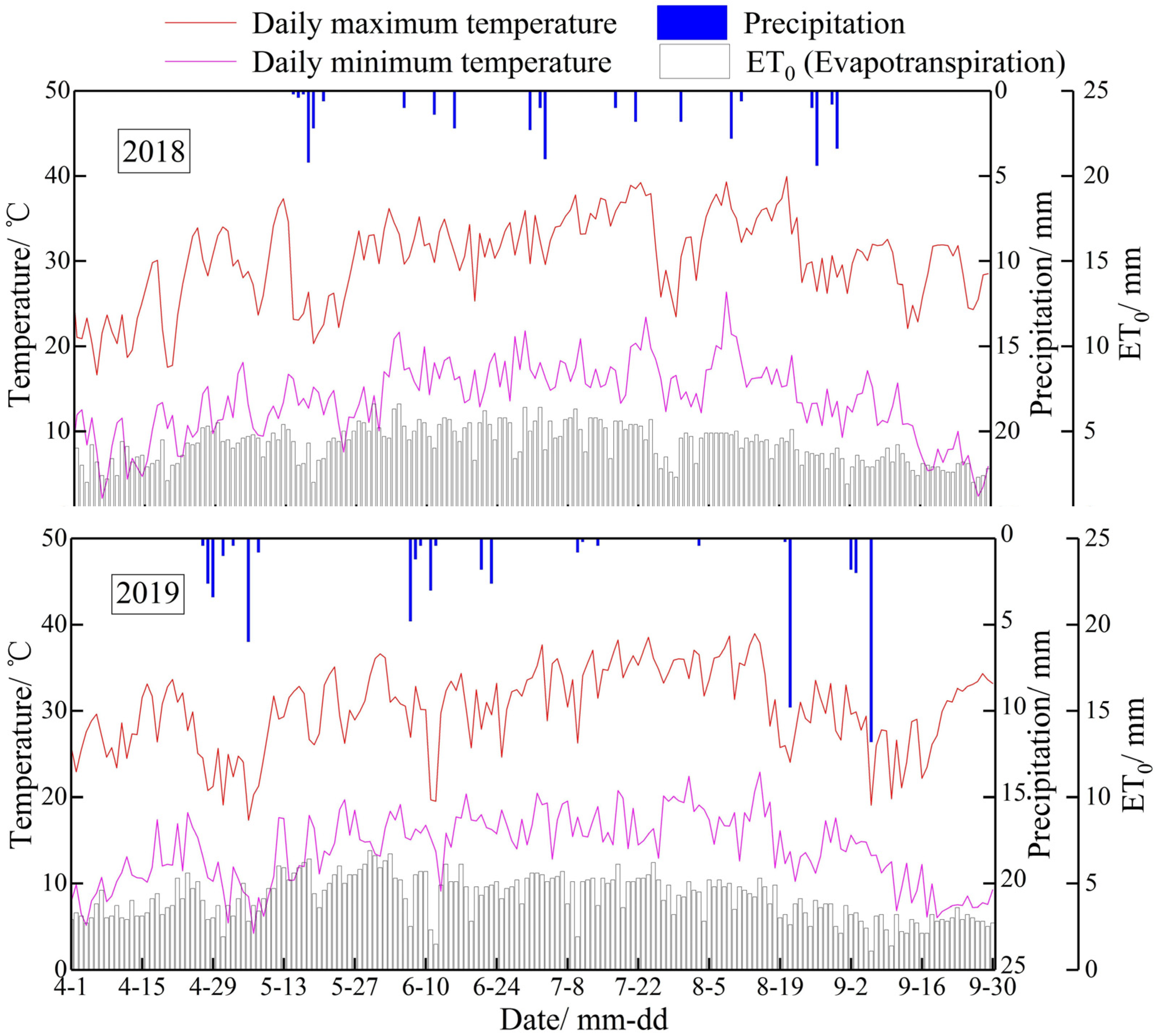

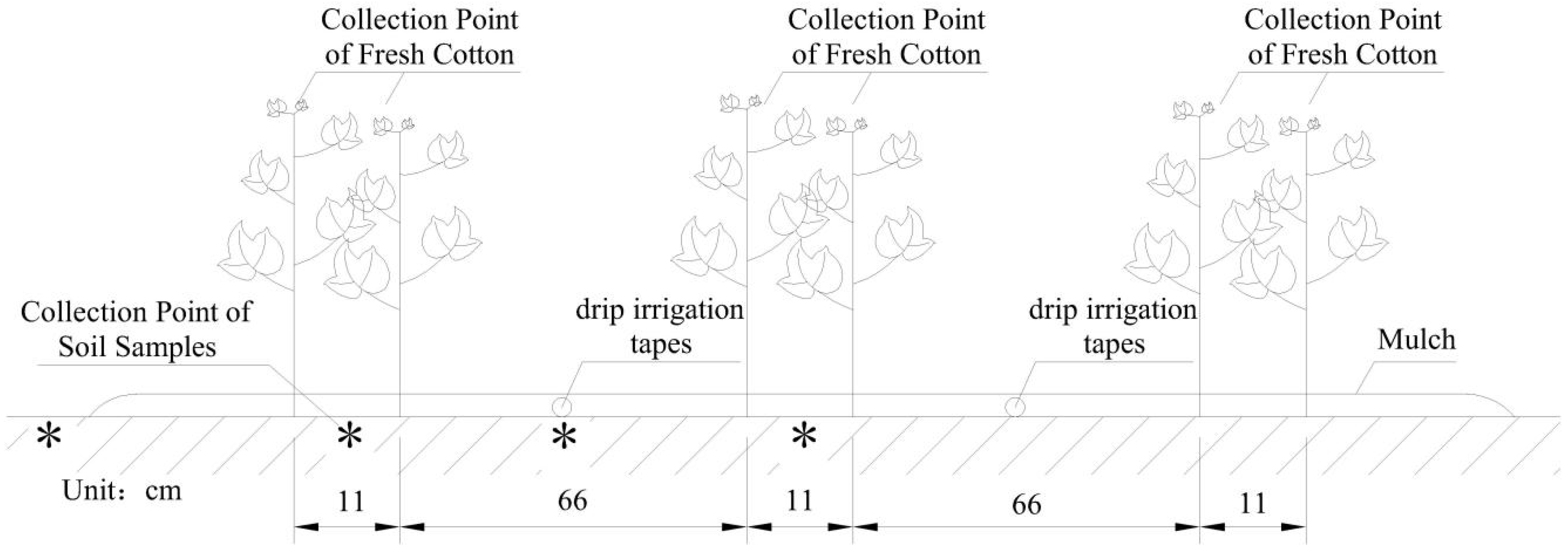
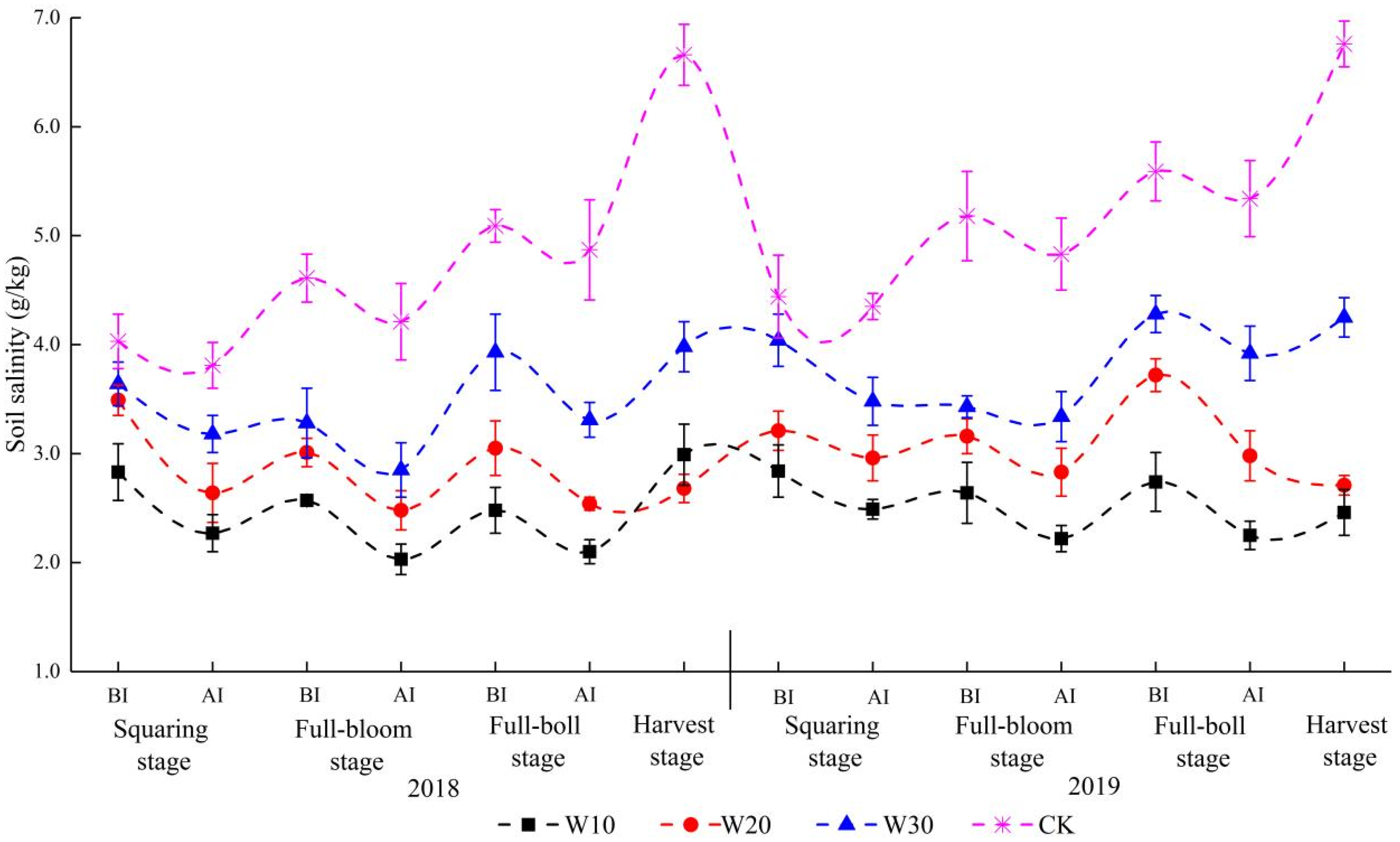
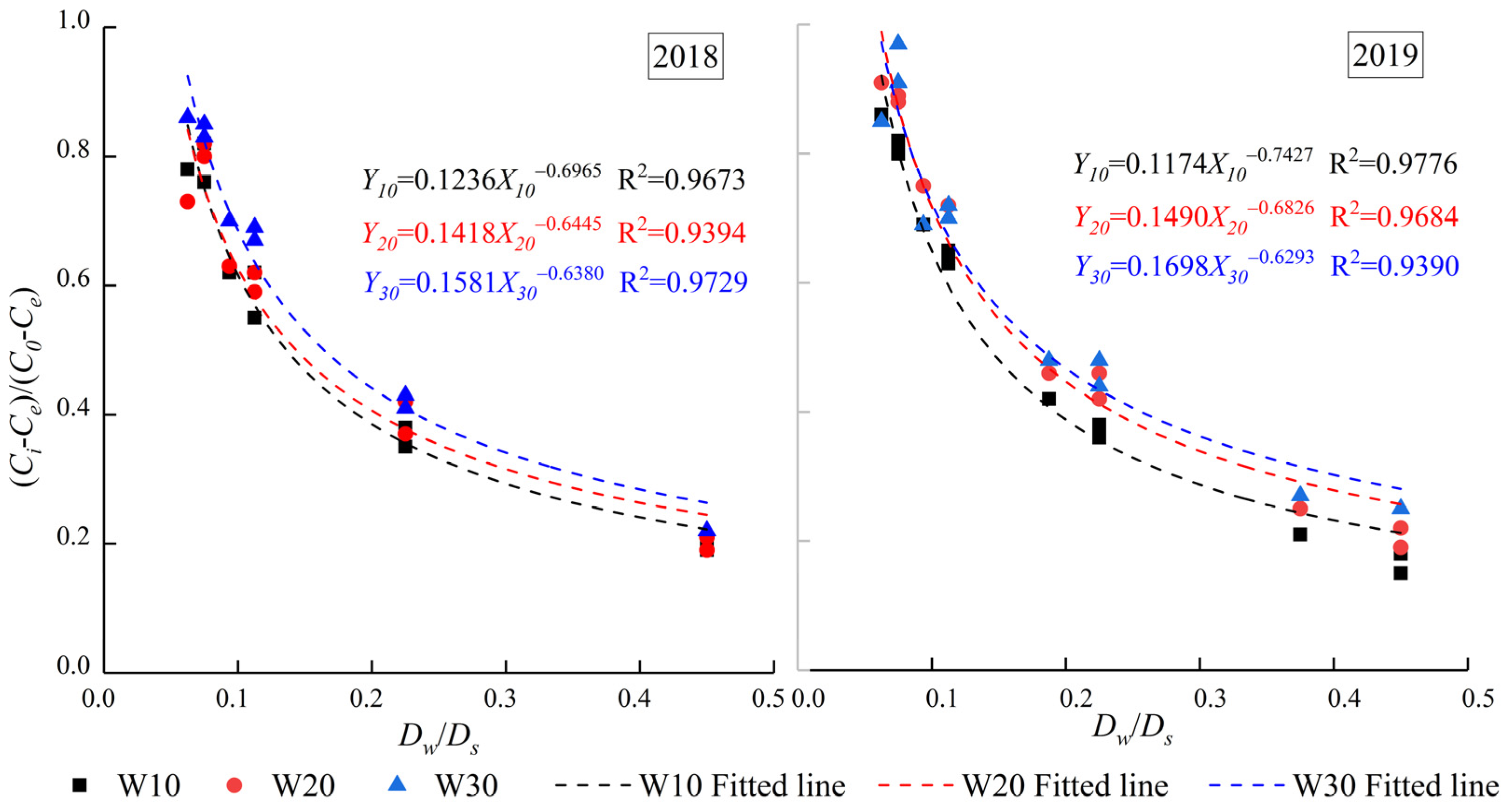
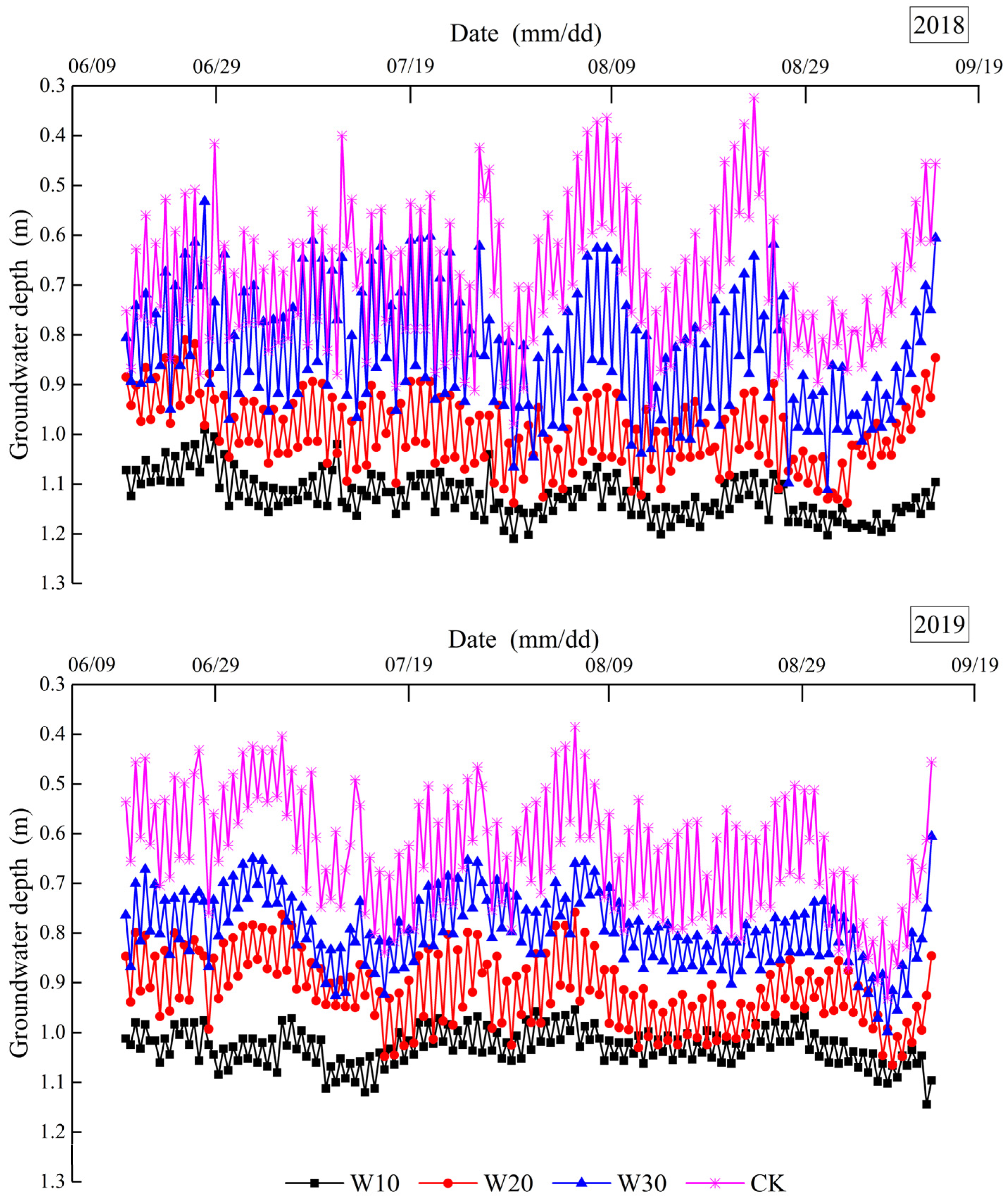

| Soil Depth, cm | 0–20 | 20–40 | 40–60 | 60–80 | 80–100 | |
|---|---|---|---|---|---|---|
| Soil bulk density, g/cm | 1.51 | 1.48 | 1.43 | 1.34 | 1.36 | |
| Saturated soil moisture, % | 32.11 | 34.03 | 36.88 | 37.71 | 37.89 | |
| Field water-holding capacity, % | 26.25 | 27.06 | 30.83 | 32.31 | 33.68 | |
| permeability coefficient, cm/d | 11.2 | 8.8 | 8.1 | 8.6 | 7.9 | |
| Soil texture | Sand, % | 66.32 | 68.82 | 76.51 | 84.46 | 91.84 |
| Silt, % | 29.63 | 27.26 | 21.36 | 12.07 | 6.63 | |
| Clay, % | 4.05 | 3.92 | 2.13 | 3.47 | 1.53 | |
| Year | Irrigation Date (d-m) | Irrigation Quota (mm) |
|---|---|---|
| 2018 | 28-Jun | 37.5 |
| 11-Jul | 45 | |
| 25-Jul | 45 | |
| 2019 | 27-Jun | 37.5 |
| 13-Jul | 45 | |
| 26-Jul | 45 |
| Year | Treatment | Squaring Period | Full-Bloom Period | Full-Boll Period |
|---|---|---|---|---|
| 2018 | W10 | 19.52 ± 1.26 b | 20.86 ± 1.02 a | 15.34 ± 0.62 a |
| W20 | 24.28 ± 1.50 a | 17.65 ± 0.72 b | 16.55 ± 1.32 a | |
| W30 | 12.53 ± 0.90 c | 13.25 ± 0.50 c | 15.88 ± 0.94 a | |
| CK | 5.43 ± 0.67 d | 8.69 ± 1.04 d | 4.33 ± 1.20 b | |
| 2019 | W10 | 12.35 ± 1.16 b | 15.81 ± 1.23 a | 17.99 ± 0.39 a |
| W20 | 7.72 ± 0.34 c | 10.39 ± 0.72 b | 10.10 ± 1.15 b | |
| W30 | 14.01 ± 0.13 a | 2.68 ± 0.29 d | 8.44 ± 0.32 b | |
| CK | 2.02 ± 0.91 d | 6.77 ± 1.46 c | 4.38 ± 1.30 c |
| Year | Treatment | June | July | August | September | Average |
|---|---|---|---|---|---|---|
| 2018 | W10 | 1.063 a | 1.121 a | 1.138 a | 1.161 a | 1.12 a |
| W20 | 0.914 b | 0.995 b | 1.025 b | 0.999 ab | 1.00 b | |
| W30 | 0.772 c | 0.812 c | 0.866 c | 0.882 b | 0.84 c | |
| CK | 0.678 d | 0.706 d | 0.657 d | 0.703 c | 0.68 d | |
| 2019 | W10 | 1.018 a | 1.034 a | 1.015 a | 1.058 a | 1.03 a |
| W20 | 0.878 b | 0.898 b | 0.933 b | 0.967 b | 0.92 b | |
| W30 | 0.766 c | 0.774 c | 0.800 c | 0.869 c | 0.79 c | |
| CK | 0.573 d | 0.614 d | 0.637 d | 0.787 d | 0.64 d |
| Year | Soil Salinity before Leaching, C0 (g/kg) | Soil Salinity after Leaching, Ci (g/kg) | Theoretical Drip Irrigation Leaching Quota (mm) | ||
|---|---|---|---|---|---|
| W10 | W20 | W30 | |||
| 2018 | 5.0 | 2.0 | 129.8 | 142.0 | 168.1 |
| 1.5 | 215.6 | 245.6 | 290.8 | ||
| 1.0 | 475.7 | 577.7 | 684.0 | ||
| 3.0 | 2.0 | 58.3 | 59.8 | 70.8 | |
| 1.5 | 96.8 | 103.4 | 122.5 | ||
| 1.0 | 213.6 | 243.3 | 288.0 | ||
| 2019 | 5.0 | 2.0 | 133.2 | 165.5 | 182.6 |
| 1.5 | 214.4 | 277.6 | 320.1 | ||
| 1.0 | 450.3 | 622.5 | 768.6 | ||
| 3.0 | 2.0 | 62.9 | 73.1 | 75.3 | |
| 1.5 | 101.2 | 122.7 | 132.0 | ||
| 1.0 | 212.6 | 275.1 | 316.9 | ||
Publisher’s Note: MDPI stays neutral with regard to jurisdictional claims in published maps and institutional affiliations. |
© 2022 by the authors. Licensee MDPI, Basel, Switzerland. This article is an open access article distributed under the terms and conditions of the Creative Commons Attribution (CC BY) license (https://creativecommons.org/licenses/by/4.0/).
Share and Cite
Yang, Y.; Li, D.; Huang, W.; Zhou, X.; Li, Z.; Dong, X.; Wang, X. Effects of Subsurface Drainage on Soil Salinity and Groundwater Table in Drip Irrigated Cotton Fields in Oasis Regions of Tarim Basin. Agriculture 2022, 12, 2167. https://doi.org/10.3390/agriculture12122167
Yang Y, Li D, Huang W, Zhou X, Li Z, Dong X, Wang X. Effects of Subsurface Drainage on Soil Salinity and Groundwater Table in Drip Irrigated Cotton Fields in Oasis Regions of Tarim Basin. Agriculture. 2022; 12(12):2167. https://doi.org/10.3390/agriculture12122167
Chicago/Turabian StyleYang, Yuhui, Dongwei Li, Weixiong Huang, Xinguo Zhou, Zhaoyang Li, Xiaomei Dong, and Xingpeng Wang. 2022. "Effects of Subsurface Drainage on Soil Salinity and Groundwater Table in Drip Irrigated Cotton Fields in Oasis Regions of Tarim Basin" Agriculture 12, no. 12: 2167. https://doi.org/10.3390/agriculture12122167





